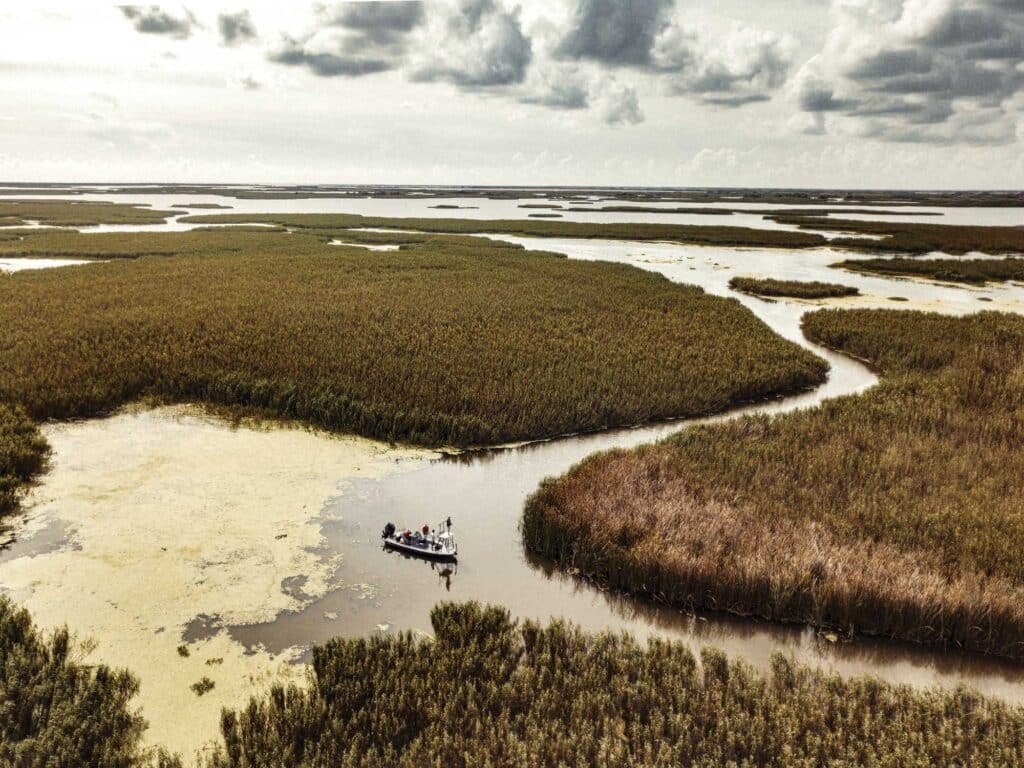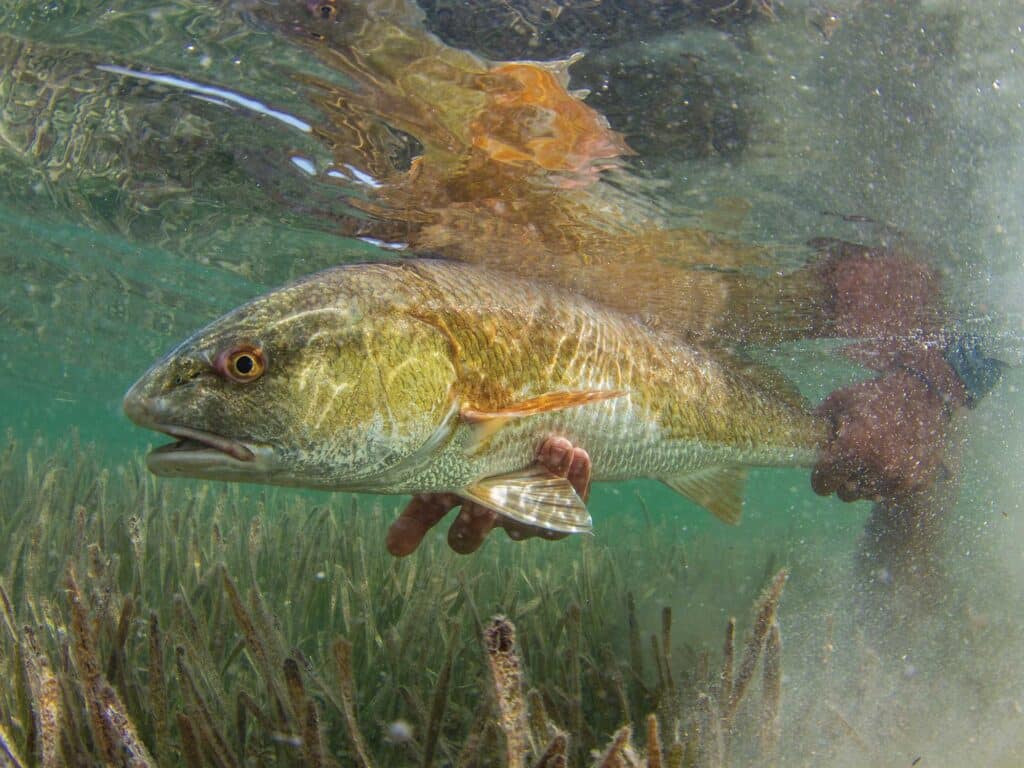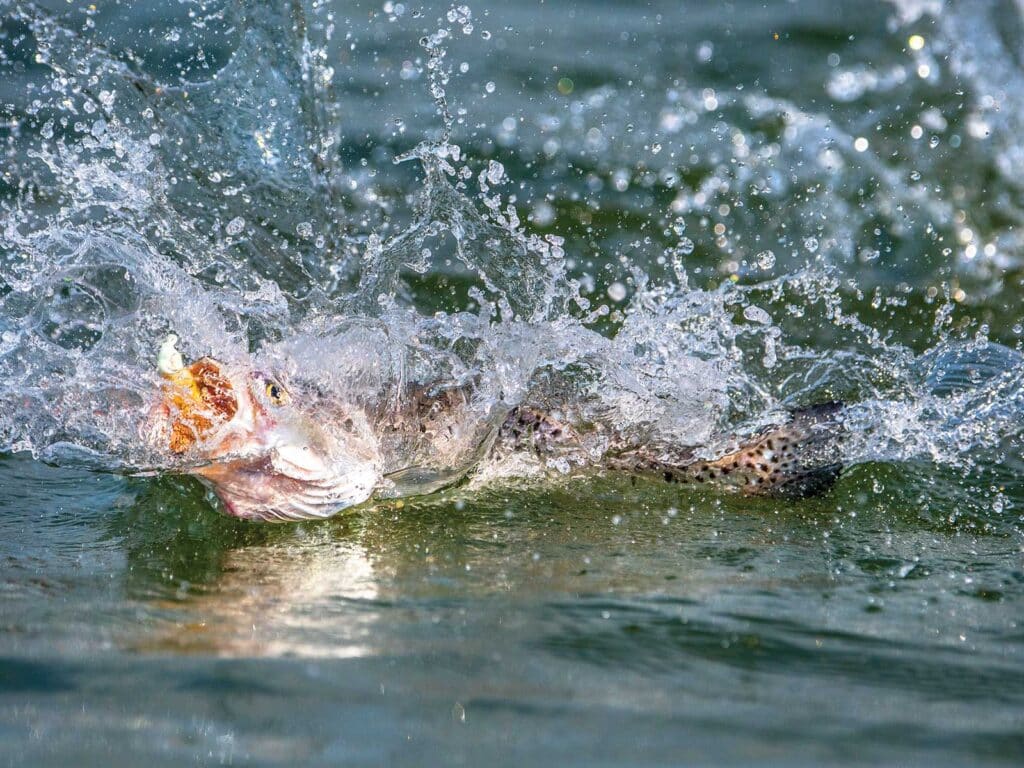
For setting out on a warm-season slugfest with hard-charging redfish and tasty speckled trout, it’s tough to top the Mississippi Delta. But when fall finally yields to Old Man Winter, this gem of southeastern Louisiana will still produce epic fishing. The fish just adjust their habits. You should too.
As a rule, reds tend to be a hardier species than trout. They both face the same weather patterns year after year, but specks lack the tanklike construction that gives redfish greater endurance and tolerance.
“Redfish will stay shallow right up until the coldest weather,” says Capt. Eddie Adams, of Metairie, Louisiana. “And as soon as we get a [winter warming trend], they’ll move shallow again because it’s easier for them to feed.”
Capt. Anthony Randazzo, who operates Paradise Plus Guide Service in Boothville, Louisiana, agrees. He says redfish will eat even during the harshest winter conditions. Specks, though, get lockjaw when cold fronts bring falling temperatures and rising barometers.
“Redfish are almost always active and catchable in the winter,” Randazzo says. “It might take three days for specks [in the marsh] to recompose themselves after a sharp cold front, whereas redfish will bite before, during and after the fronts.”
Movement Matters
As Randazzo explains, juvenile “slot” reds migrate to the inner marshes in late September and stay there all winter. Marsh trout will have made their way as far inland as possible by November, usually to the levees that border the river, while the trout living in the passes will move upriver.
It’s important to note that water levels in the Mississippi River have profound impacts on the delta region, particularly the areas in and around the coastal passes. Essentially, the lower the river, the farther inward salt water extends; the higher the river, the less so.
Randazzo says that redfish will tolerate lower salinities and remain near the main river or within the tributaries, closer to the open water of the coastal bays. Trout, however, will flee lower salinities and move to the deeper areas of coastal bays.
“If the river stays low and salinity remains high, we find trout as far up the Mississippi River as the Empire locks, and occasionally farther,” Randazzo says. “Most people don’t really think to look that far up the river. It can be some of the easiest days of the year for trout fishing.”
Where They Go
The delta’s vastness offers countless potential winter hidey-holes, but consider the common threads of temperature and shelter. Depending on a given day’s weather complexion—standard winter chill versus a harsh frontal system—the fish may or may not be in their refuges. Either way, they won’t be far.
One thing to look for is wind breaks and leeward spots that minimize rough-wave exposure. The fish can survive plenty of chop, but winter winds are cold, and excessive turbulence impedes feeding.
Also key to consider: Depth equals stability. Cozy deepwater retreats will sustain the fish when winter tightens its icy grip.

Redfish
Delta guide David Iverson knows that redfish aren’t easily shaken, but when winter’s worst tests their resolve, they don’t want to run far for comfort. That generally means deep marsh cuts and canals with filtering grass lines, feeding flats and shell bottom.
As Iverson explains: “Those redfish will come out of the marshes and get in those areas when it’s really cold. They’ll look for a little area with 4 or 5 feet of water or deeper where they can hang out until the weather warms up. If it’s not really cold, they’ll stay up in the shallows in the same places they were the rest of the year.”
One tip for finding winter redfish in deeper canals is to always check the various drilling-industry structures; these wooden platforms and metal equipment absorb heat, just like the rocks, shell and mud bottom.
“The slot reds will start out ultra-shallow and move to the 2- to 4-foot areas once the fronts start pushing the tide below average,” Randazzo explains. “As temperatures continue to drop, the slot reds in the marsh will find their way to the few remaining dead-end canals with 4 to 8 feet of water.
“The fish in the river system will seek out shallow flats and marsh areas close to the river. Basically, all of the backwater areas along the river will hold slot reds until it gets pretty cold in November. Once the temperatures drop, the fish slowly move deeper and hold on points and drains in the river and passes.”

Trout
Adams finds the deeper bends of bayous and canals most consistent for winter trout. Discover such areas with shallow feeding zones littered with space heaters, and you’re in business.
“They like to be in deep water close to a flat in 3 feet or less because that gives them some place to feed,” Adams says. “They like shell, clay, or roots from old bushes—things that heat up with the sunshine. Even the rocks that people use to stabilize their camps (hunting and fishing structures built in the marsh) will hold heat in the wintertime.”
As Randazzo explains, the shallower marsh areas are more affected by winter’s chill because the fish have no fall-back areas. During harsher weather, the trout can only sit tight and wait for better conditions.
“The trout dwelling in the deeper waters of the river and passes can slip into the many ledges and hold in these comfortable areas,” Randazzo says. “They will continue to feed in the deeper water, whereas fish in the shallow water will take a couple of days off until conditions moderate.”
Another consideration: “The trout in the marsh are limited to how far they can migrate,” Randazzo says. “Once they hit the ‘wall’ (the river levee), they move only short distances along that divider. But trout in the river have an endless distance to migrate as long as the salinity is high.”
What They Like
If stable weather—or even a warming trend—has the reds in a chasing mood, you’ll fare well by covering water with shallow-diving crankbaits in craw or chartreuse-and-black backs, bladed jigs with minnow trailers, spinnerbaits or spoons. Iverson is a fan of Bomber’s Who Dat weedless rattling spoon—in particular, the gold with orange accents.
“If you look at the crabs and the cocahoe minnows, most of them have a little tinge of orange or red in them,” Iverson says. “When you add that little bit of orange flashing back and forth in that spoon, it looks like [what the redfish eat].
“Fish reaction baits along marsh-grass edges, and pay particular attention to the areas outside the mouths of marsh drains, which serve as redfish food funnels on falling tides.”
Randazzo likes bouncing 1/8- to 1/2-ounce unpainted jig heads with 4-inch shad tails along the bottom. In stained or cold water, spraying or dipping baits in scented fish attractant helps.
Adams likes Matrix Shad swimbaits and Marker 54 shrimp, both on leadheads or under a cork. This isn’t Florida Keys bonefishing, so just get it in the neighborhood and it’s game on.
“If the weather’s stable, those redfish will be up shallow feeding,” he says. “They’ll eat whatever you put in front of them.”
Randazzo also fishes Carolina-rigged live or artificial shrimp, topwater plugs and live shrimp under popping corks. During cold spells, Iverson throws a Bomber Mullet into the deeper holes and works the water column with a jigging motion. Randazzo does the same with a jigging spoon.
For speckled trout, Randazzo starts with plastics on unpainted jig heads (in deeper spots) or under corks (shallower). If the bite is tough, live shrimp or croakers under corks do the trick.
“We will downsize lures in winter to entice bites from wary trout,” Randazzo says. “Live bait will frequently outshine all other options on the coldest days with the least water clarity.”
When winter gets particularly wintry, pay attention to those deeper canal bends and tide-carved pockets along Roseau cane edges. Trout will stack thickly along these isolated refuges, so if you catch one fish, park for a bit and give the spot time to produce.
Parting Pointers
Make the most of your winter days with a few delta considerations.
Tides: These are even more important during the winter. Randazzo expects marsh trout to be most active on high tides when the water is cleaner. Those in the passes can be more active on low tides because they have plenty of deeper water structure to host their feeding.
“The best time to fish winter redfish in the marsh is when the tide is falling until it hits rock bottom,” Randazzo says. “Once the tide swings around, the slot redfish become far less interested in feeding. In the river system, we usually can catch some slot reds on the rising tide, but the falling tide is superior.”
Adams likes a high outgoing tide for trout, especially when they’re over oyster reefs. For sight-fishing reds, he loves when sunny conditions and a long, outgoing tide give him several hours of fishing. “In a skinny-water skiff, you can sneak right up on them.”
Read Next: Bait for Winter Fishing
Weather wisdom: Winter might seem like a dull, dreary season, but don’t get lulled into laziness.
“Frequent cold fronts and changing water conditions will play a big part in where your fish will be catchable,” Randazzo says. “Take some time to analyze what’s happening each day on the water, the conditions present for the day you are fishing, and how it all lines up with your plan.
“If you force something based on what you recently experienced or what a friend conveyed to you, it might be a recipe for disaster.”
Patience pays: Winter bites might come slowly, but once tides and major or minor feeding periods align, flurries are common. Redfish definitely have their peak periods, but they’ll eat all day in all but the nastiest conditions. Trout, Randazzo says, often require more persistence.
“While winter trout fishing, don’t give up on a spot after just a couple of bites. Use your electronics to see what is really around. I also like to use the solunar tables to see if I should expect more action later in the day.”
Don’t rush: Pre-dawn launching might serve warm-season efforts, but Randazzo says it’s often more productive to give the rising sun time to set the stage.
“The biggest mistake for winter fishing is leaving the dock at dark thirty and expecting the fish to be feeding actively. Take your time and enjoy the extra sleep.”









